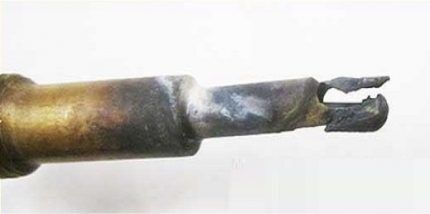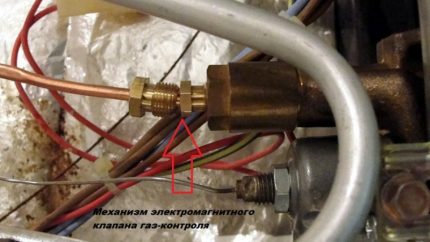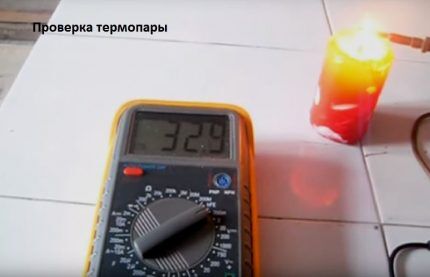Thermocouple in a gas stove: principle of operation + instructions for replacing the device
Cooking on a gas stove or gas hob is as easy as cooking on regular electric burners.Even using a gas oven rarely causes any problems. But many people immediately raise the question of the safety of such equipment, because “blue fuel” is explosive.
Hardly anyone wants to see their home destroyed as a result of a gaseous fuel explosion. To prevent such a tragedy, a device such as a thermocouple is used in a gas stove. It represents the main element of the health monitoring system of the most popular gas appliance.
Agree that in the case of natural gas, special attention must be paid to the topic of reducing the risks of fires and explosions. The article we presented provides and describes in detail the rules for operating household equipment that processes gas. We supplemented the useful information with valuable recommendations.
The content of the article:
Why does a gas stove need a thermocouple?
The gas in the stove burner is ignited with matches, a manual piezo lighter or a built-in electric ignition. Then the flame should burn on its own without human intervention until the fuel is turned off by the valve.
However, often the fire on a gas hob or oven goes out as a result of a gust of wind or a splash of water from a boiling pan. And then, if there is no one nearby in the kitchen, methane (or propane) begins to flow into the room. As a result, when a certain concentration of gas is reached, a bang occurs with fire and destruction.

The working function of a thermocouple is to control the presence of a flame. While the gas is burning, the temperature at the tip of the control device reaches 800–1000 0C, and often higher. As a result, an EMF arises, which keeps the gas solenoid valve on the nozzle to the burner open. The burner is working.
However, when the open flame disappears, the thermocouple stops producing EMF to the electromagnet. The valve and fuel supply are shut off. As a result, the gas does not enter the kitchen without accumulating in it, which eliminates the possibility of a fire from such an emergency situation.
A thermocouple is a simple temperature sensor without any electronic devices inside. There is nothing to break in it. It can only burn out from prolonged use.
You will get acquainted with a full set of sensors designed to control and safety the operation of a gas water heater. next article, entirely devoted to this interesting issue.

Among the advantages of thermocouples:
- simplicity of the device and the absence of breaking mechanical or burned out electrical elements;
- the device is cheap - about 800–1500 rubles, depending on the model of the gas stove;
- long service life;
- high efficiency of flame temperature control;
- quick gas shut-off;
- ease of replacement, which you can do yourself.
The thermocouple has only one significant drawback - the difficulty of repairing the device.If the thermocouple sensor is faulty, it is easier to replace it with a new one.
To repair such a device, it is necessary to weld or solder at high temperatures (about 1,300 0C) two different metals. It is extremely difficult to achieve such conditions in everyday life at home. It is much easier to buy a new control unit for a gas stove as a replacement.
Design and principle of operation
The operation of a thermocouple is based on the thermoelectric Seebeck effect. According to it, at the ends of conductors connected in series from different metals, provided that their contacts are at different temperatures, thermo-emf (TEMF) occurs.
That is, it is necessary to have two conductors of different compositions that can withstand intense heat, and high-temperature heat (in this case from combustible natural gas) at the point of their connection.
In most pairs, the electromotive force that arises between the cold and hot contacts is very small and of little use. But there are metals and alloys, the combination of which gives up to 4–5 mV/100 0S. And this is already quite enough to control the electromagnet that controls this or that gate.

The operating principle of thermocouples built into gas stoves is extremely simple:
- There is a flame - TEMF appears between the contacts, the valve for the gas supply to the burner is open.
- There is no fire - the thermoelectric force disappears, the valve closes under spring pressure and shuts off the gas.
A thermocouple consists of two thermostable conductors up to one and a half meters long, which are connected at one end by soldering or welding.
It is this tip that is directly in the fire and is heated by the burning gas. The second end of the device is a pair of contacts or a connector for connecting to a solenoid valve.
Types of temperature sensors for gas
Thermocouples of gas stoves differ in the alloy of conductors and the type of connection to the valve. And the main thing here is that each manufacturer of gas-powered equipment uses its own versions of electromagnets with different connection connectors.
In most cases, it is impossible to move the thermocouple gas control sensor from one tile to another.

The following alloys and metals are used to create thermocouples:
- constantan + chromel;
- copper + constantan;
- copper+copel;
- nisil + nichrosil;
- alumel+chromel;
- constantan+iron;
- chromel+copel;
- platinum+platinum;
- tungsten+rhenium.
The accuracy of the device and its operating temperature range depend on the alloys used. For example, a chromel-alumel thermocouple is designed to operate at 0–1100 0C, iron-constant at 0–700 0C, and platinum-platinum-rhodium can withstand heating up to +1700 0WITH.
Household gas stoves usually use thermocouple sensors made of alumel and chromel or constantan and iron. They are inexpensive and quite suitable for the temperature conditions of a gas cooktop.
Gas control repair manual
If the gas on the stove goes out, then the problem may lie not only in the thermocouple. However, most often this is precisely the problem.
The main sign of problems with gas control is that after igniting the burner and releasing the handle or button to open the “blue fuel”, the flame immediately goes out.This occurs due to the valve closing, since the thermo-EMF to keep it open is absent or insufficient.
Causes of noise gas stove burners are described in detail in the article, the useful information of which is worth reading.

You should independently check, repair and replace the thermocouple in a gas stove with your own hands only when the gas is completely shut off. First you need to close the valve cylinder with gas mixture or a pipe with methane, and only then begin any work. Also, do not forget about turning off the power supply if the design contains volatile devices.
The thermocouple tip is located directly next to the burner and gas fire. And in the oven you can find it near the flame divider in the upper part of the oven. This tip should be free of carbon deposits, mineral deposits and any damage.
If the working tip of the thermocouple sensor is covered with scale, it must be cleaned off with sandpaper. The more carbon deposits, the less heat reaches the thermocouple, and the less it accordingly creates an EMF. The resulting millivolts may simply not be enough to open the solenoid valve.
How to check before replacing?
The thermocouple usually has one tip for installation near the fire. But there are also options with two or three temperature control tips. They are usually used in ovens, but it all depends on the specific model of the stove.
Thermocouples with several working tips have a peculiarity - if only one of them is not heated or fails, the solenoid valve will be closed. Therefore, in order to accurately find the cause of the problems, such thermocouple devices will have to be checked especially carefully. Only one of the sensors may be faulty.

Another point is that the thermocouple conductors in the area up to the valve must be tensioned or dangling in the body of the plate. At the same time, their connection to the electromagnet must be rigid; a connector hanging “on my word of honor” is unacceptable here.
The devices in question are produced with lengths from 40 to 130 cm. You should choose a thermocouple gas monitoring device based on this indicator very carefully. On the one hand, the conductor wire should not be over-tensioned, and on the other hand, it should not lie on heated surfaces or dangle freely.
How to change the device?
Before replacing a damaged thermocouple in a gas stove, you should inspect the device for:
- the presence of carbon deposits on the working tip (if there is any, it must be cleaned off with sandpaper);
- no burnout of this tip (in this case, only complete replacement);
- the rigidity of the connection between the contacts of the thermocouple sensor and the valve (if necessary, tighten);
- serviceability of the thermocouple itself with the output of an EMF at a level of at least 15 mV when heating.
The device in question should only be replaced when it is definitely faulty. In many cases, to get a gas stove to work again, you can get by by cleaning the tip from carbon deposits and checking the contacts.

The working tip of the thermocouple is rigidly fixed near the burner or burner using a nut. If it cannot be unscrewed due to scale, then you should not put too much pressure on the key. This can only break the fastening. It is better to use a solvent first.
The second end of the thermocouple is attached to the solenoid valve using a threaded connector or two crimp contacts. Removing them doesn't seem difficult. The new thermocouple sensor is installed in a similar sequence - one end of it is attached near the burner, and the other to the electromagnet.
Conclusions and useful video on the topic
How to replace a thermocouple with your own hands:
The operating principle of gas control in the hob and oven:
Thermocouple device for gas stoves:
A gas stove without a properly working thermocouple is a source of danger. If the gas control has stopped functioning, it is quite possible to replace the sensor yourself. There is nothing difficult about dismantling the old and installing a new control device. You just need to purchase a device that matches the existing tile model and work a little with a gas wrench and a screwdriver.
If you have comments on the topic or your own observations on the above information, write them in the block below. We, as well as other readers, will be interested in your stories about the nuances of replacing a thermocouple that you made yourself. Write, don't be shy.




How to choose a thermocouple for a delongy oven? And where to buy?
gas stove Gorenye K5341WF the tip of the thermocouple sensor burned out, I can’t buy a new one anywhere, something that can be replaced from another model
Competent advice and a good video without unnecessary chatter.